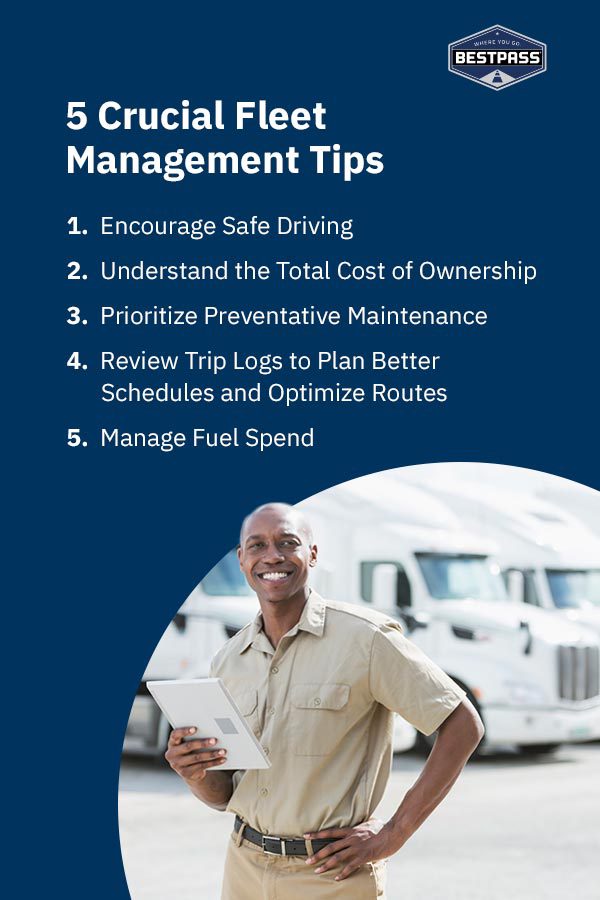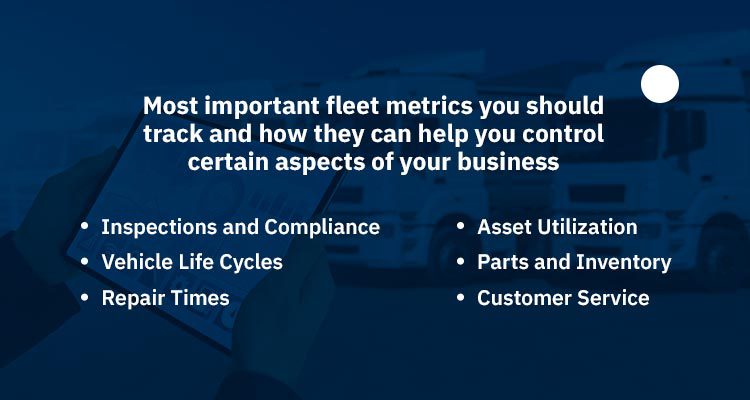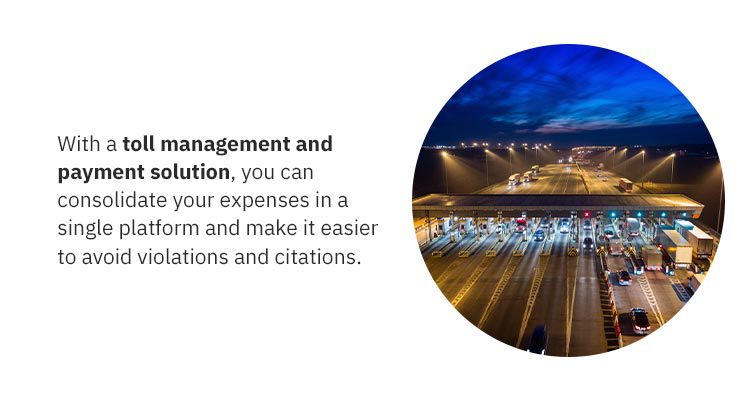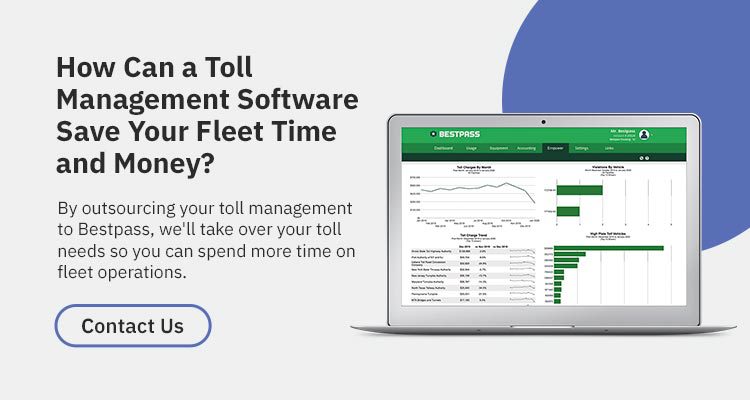
Tips for Managing a Fleet
According to the American Transportation Research Institute (ATRI), toll costs for commercial vehicles are higher than in other industries, and overall costs have increased significantly, rising almost 73% in the last 10 years. The challenges with rising costs mean it’s more expensive to run your business and you need to look for new ways to save money on tolls.
Investing in a dependable toll fleet solution means you get to spend more time focusing on your vehicles, drivers and business and less time dealing with tolling authorities. We wanted to share some key fleet management practices and the benefits of simplifying toll processes.
5 Crucial Fleet Management Tips
Managing a fleet, regardless of size, comes with many responsibilities. It can be difficult to manage every critical function across your organization, from customer service to driver safety to inventory. Here are five good fleet management practices to help you improve your processes:

1. Encourage Safe Driving
Thorough training and education for drivers are critical to helping improve safety and vehicle maintenance issues in your fleet. Therefore, drivers should know how to identify potential indicators of their trucks and vehicles, including:
- Ignition delays
- Strange noises
- Unusual vibrations
- Thick exhaust smoke
- Higher than usual idle Revolutions Per Minute (RPM)
By paying attention to their vehicles and following a checklist of items to inspect during their drives, your drivers can help you care for the fleet. Good driving behavior can also help minimize how hard the engine works. Over time, driving improvement can reduce repairs, liability and costs and enhance efficiency. When drivers know they’re accountable for their vehicles, they’ll likely get in fewer accidents, avoid penalties and even use less fuel.
2. Understand the Total Cost of Ownership
The total cost of ownership (TCO) is an estimate of costs that can help you determine direct and indirect expenses associated with your fleet operations. This allows fleet managers to make better-informed decisions regarding:
- Vehicle and manufacturer selection
- Asset lifecycle management
- Budgeting and planning
- Leasing or buying
Knowing the TCO can give you a clearer view of the full cost of owning a fleet, or expanding your current fleet, and how you can maintain it in the most financially efficient manner. After all, one of your top priorities as a manager or leader of a fleet is to stay within your budget and manage costs.
If you find yourself paying for repairs frequently, seeing poor fuel consumption or receiving high payments, you may want to weigh your options and see what works best for your business. Be sure to review the warranty coverage on your vehicles so you can determine how it may impact the TCO over time.
3. Prioritize Preventative Maintenance
Constant repair and downtime can create excessive expenses and slow your business growth. One of the most critical service fleet management tips is to make preventative maintenance a priority so you can reduce the likelihood of consistent repairs and keep your fleet on the road.
To take a proactive approach, consider making a maintenance schedule for your fleet vehicles and have each one serviced periodically to avoid major breakdowns or extensive repair issues. Areas for preventative maintenance can include:
- Oil changes
- Tire rotation
- General safety checks
- Changing brakes
- Topping off fluids
Taking better care of your vehicles will also set an example for your employees, who can participate in regular checkups and inform you of any unusual problems during their drives. This can help you keep your vehicles in service longer, minimize unexpected downtime and allow you to remain compliant with Department of Transportation inspections.
4. Review Trip Logs to Plan Better Schedules and Optimize Routes
An important fleet management strategy for optimization is to review your usual routes, locations, shipments and driver activity to improve your driver schedules. As your fleet grows, you may see more inefficiencies occur as it becomes difficult to navigate around traffic or as drivers may incorporate more personal travel into their routes.
It’s crucial to execute periodic audits of your driving logs. As you do, be sure to look for unnecessary travel and communicate with your drivers about your policies to help them maintain sustainable performance. This can help your fleet function as efficiently as possible.
5. Manage Fuel Spend
One of the most significant costs you likely face in fleet management is managing your fuel spend. Because fuel prices are subject to common fluctuations that are out of your control, the best way to minimize fuel costs is to improve your fleet’s fuel efficiency. Do so by optimizing your drivers’ routes, as mentioned above, and monitoring your drivers’ behavior to ensure they avoid speeding, hard stop and hard accelerations.
6. Manage Citations & Violations
A specific way to manage driver behavior is working with a payment platform that can help you understand your toll, citation and violation costs by vehicle. Bestpass has customers that have seen improved safety for drivers and reduced citations and violations after using the service.

What Metrics Are Important?
You can’t improve what you can’t measure. Before implementing the tips above, it’s important to use data and analytics to gain more insights into your fleet and costs. Consider how much more information you can learn with the help of improved technology to help manage your fleet more effectively.
With key performance metrics (KPIs), you can use the data and information you collect about your fleet through your software program to improve your fleet’s performance or tackle specific areas you need to enhance for efficiency or compliance. Let’s look at the most important fleet metrics you should track and how they can help you control certain aspects of your business.
Fleet Metrics You Need to Be Tracking
Inspections and Compliance
If you’re not on the ball with compliance, you could incur costly violations, fines and penalties that impact your business reputation and budget. By checking your Daily Inspection Vehicle Reports (DVIR), you can gain insight into the health of your vehicles and ensure your fleet remains compliant. You or your drivers should complete a DVIR daily to inform you of any mechanical issues and allow you to keep a complete record of your fleet’s history to prove compliance.
Reviewing DVIR data can also help you schedule preventative maintenance more effectively, identify patterns in your fleet and decrease overall downtime.
Vehicle Life Cycles
It can be difficult to figure out when to replace your vehicles. Buying or leasing a fleet vehicle can be expensive, but at a certain point, making constant repairs to older vehicles can become redundant and a waste of money. If your vehicles stay in operation for too long, their performance will start to decline, leading to more downtime, frustrated drivers and even lower business efficiency.
To help determine the best replacement life cycle for your fleet vehicles, you can consider the service history, odometer readings and general cost of ownership. By studying these metrics, you can make an informed decision about whether you should hold on to a particular vehicle or when it’s time to invest in a new one.
Repair Times
Managing downtime and repair turnover is an important issue because the more your vehicles are off the road, the more money you could lose. Whether you’re conducting maintenance repairs in-house or outsourcing them, it’s critical to track how much time your vehicles spend in the repair shop and ensure you’re working with a technician who can get the job done quickly at a reasonable rate.
Monitoring the metrics on the length of time it takes for your repairs to be completed — and whether they adhere to their original quote — can help you decide if you want to continue using them or find a better alternative.
Asset Utilization
One of the most important fleet metrics is monitoring vehicle use and idle time. Investing in fleet vehicles is expensive, so it’s essential to get the most use out of your assets and maximize their life spans.
Keeping track of hours of use or miles per day gives you insight into which trucks and vehicles your drivers use too much or not enough. While you may think underutilized vehicles are not much of a problem, having too many vehicles you don’t need can lead to unnecessary expenses and enough idle time that you may want to sell a few. On the other hand, not having enough vehicles can make it challenging for you to keep up with demand.
By monitoring your asset utilization, you can maintain a sustainable fleet size and manage your preventative maintenance scheduling, as you can determine which vehicles need the most TLC.
Parts and Inventory
There can be nothing more inconvenient than needing a part to fix one of your top-performing vehicles and realizing you don’t have it on hand. If you conduct maintenance and repairs in-house, you need to have the right parts and tools on hand at all times to minimize vehicle downtime and repair turnover times. It’s important to track your part quantities and other crucial inventory to reduce unnecessary expenses and avoid stockouts.
By regularly reviewing your inventory and part order history, you can place orders ahead of time when supplies are low and ensure you never run out of parts or inventory that are in high demand.
Customer Service
Even if you have the newest and most efficient vehicles on the road, if you don’t have customers, you may never see a profit or return on your investment. While it’s critical to ensure your fleet and drivers are well-managed, you also need to focus on providing excellent customer service that will allow you to build a loyal customer base.
Monitoring your internal and external customer service can help grow your business and set the standard for all employees in your company to provide quick response times and meet the demands of your consumers.
Some metrics you can track to improve your customer service include:
- How long you keep customers on hold
- How long it takes to resolve a complaint or problem
- How fast you can respond to a customer about an order
To continuously improve your service, consider sending out brief surveys or allowing your customers to give feedback and rate your service. You can even put your company phone number on the back of your fleet vehicles so drivers can receive feedback on their driving safety and improve their performance.

How to Manage Tolls and Violations
As a fleet manager, you likely try to avoid complications with tolls, violations and citations in your business. As your drivers go through dozens of tolls on a daily basis, keeping track of toll passes, charges, discounts and finding the right transponders for each vehicle can be challenging.
On top of that, managing toll violations, citations, and general processes can be time-consuming and cause you to take attention away from the core functions of your business. Overall, the larger your fleet is, the bigger responsibility you have to manage costs and ensure your fleet has the proper coverage.
With a toll management and payment solution, you can consolidate your expenses in a single platform and make it easier to avoid violations and citations. At Bestpass, we provide coast-to-coast coverage under one account and give you one point of contact/ and one bill so you can easily manage your tolling needs.
Through the Bestpass portal, we empower business owners and fleet managers to:
- Reduce time managing violations and citations: Our platform contains a database of license plates with the tolling authorities to reduce potential violations. All you have to do is scan and upload the violation or citation and we’ll take care of the rest.
- Easily handle transponders: Using a single toll management solution allows you to streamline vehicle updates and filter your options to search for a specific transponder and gain strategic insight into your toll data.
- Save money: Many trucking and service fleets will often qualify for volume discounts when using a management tool like Bestpass. More discounts lead to higher savings for your business.
- Reduce payment errors: Our Automated Misread Identification Service (A.M.I.S.) looks for max tolls and transponder activity to adjust the toll and save you money. This system also streamlines credit requests and identifies toll misreads.
At Bestpass, we also offer on-demand reporting through our portal that allows you to view all of your fleets’ toll charges and give you insight into what routes are causing the highest expenses. You can also set alerts to notify you of unauthorized use and ensure your drivers are sticking to their tasks.
With our powerful online tools, you can simplify your job and manage your vehicles more effectively. Organizing your fleet by location or region through the Bestpass portal enables more efficient accounting and localized account management, helping you stay on track with all your toll needs.
How Can a Toll Management Software Save Your Fleet Time and Money?
Since 2001, Bestpass has been a trusted partner for fleet management owners and tolling authorities. We know that tolling can be a challenging process that takes hours for fleets. With high demand for truckers to deliver goods, it’s critical to prioritize running your fleet efficiently instead of dealing with toll violations or citations.
By outsourcing your toll management to Bestpass, we’ll take over your toll needs so you can spend more time on fleet operations. Our comprehensive payment platform provides data accuracy and industry expertise and consolidates your payments to save you time and money.
Our software gives you a detailed look at your tolling costs, identifies discounts and provides a misread service that will charge your account if the tolling authority isn’t reading your transponder to avoid violations.
Invest in Toll Management Solutions With Bestpass
Not sure which Bestpass plan is right for you? Our tolling specialists are here to help. They can identify the right transponder strategy to save you the most money and time.


